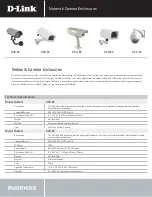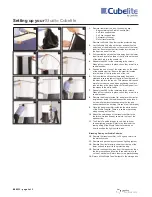
1
English User Guide
RSD Rain Sensor
The Rain Bird® RSD Series Rain Sensor is an easy to install,
durable and visually pleasing rain sensor device suitable for
24VAC residential and commercial applications. This high
quality product saves water by automatically measuring
precipitation amounts and suspends irrigation cycles when
watering is unnecessary.
!
NOTE:
The RSD Rain Sensor is a low-voltage device
compatible with all 24 volt alternating current
(VAC) control circuits and 24 VAC pump start
relay circuits. Electrical rating suitable for use with
controllers that can actuate up to ten 24 VAC, 7 VA
solenoid valves per station, plus one master valve.
DO NOT
use with any 110/250 VAC devices or
circuits, such as direct-acting pump start systems or
pump start relays.
Selecting a Location
Install the Rain Sensor in a location where it can collect
natural precipitation without interference from man-made
or natural obstructions. Place the device at a height that
deters vandalism. Avoid rain sensor mounting locations
such as those shown in
Figure 1
.
!
DO NOT
install the Rain Sensor where the device’s
ability to collect and record natural precipitation
events are affected by sprinklers, rain gutters, trees,
etc.
DO NOT
install the Rain Sensor where it could
accumulate debris from trees.
DO NOT
install the Rain Sensor in a location
exposed to high winds.
Operation
Set Rainfall Setting
The rainfall setting on the sensor determines the amount
of rainfall needed to suspend the irrigation watering cycle.
You can adjust the rainfall setting from 1/8” to 3/4” (5mm
to 20mm). Adjustments are made by turning the sensor
dial cap clockwise or counter clockwise. To set the rainfall
setting, turn the sensor dial cap until the desired rainfall
setting lines up with the arrow on the sensor body
(A)
, as
shown in
Figure 2
.
The ideal rainfall setting for your location depends on soil
type, wind, amount of direct sunlight the sensor receives as
well as frequency and amount of rainfall. The table below
gives some guidelines to help determine the appropriate
rainfall setting.
Irrigation Site Conditions
Rainfall Setting
• Sensor receives long periods of
direct sun
• Clay-type soils
1/8” to 1/4”
(3mm to 6mm)
• Frequent, heavy rains
• Sensor mounted in a mostly
shady area
• Sandy soils
1/2” to 3/4”
(13mm to 20mm)
Set Vent Ring
The vent ring determines “drying time” – the length of time
the sensor suspends irrigation after a rainfall. For most
installations set the vent ring to the fully open position.
At properties where water has a tendency to pool after
a rainfall, partially close the sensor’s vent ring. This
adjustment to the vent ring extends the period of time that
the irrigation cycle is suspended, allowing the property
time to drain.
To set the drying time, turn the vent ring below the sensor
dial cap to the desired position, as shown in
Figure 3
.
Mounting
!
NOTE:
Follow the installation instructions carefully
and install the unit only in full compliance with
the National Electrical Code (NEC) or your local
electrical code.
Bracket Model
To install the RSD-BEx Rain Sensor bracket model:
1.
Select an appropriate mounting location within 25’
(7,6m) of your controller. It is not recommended to
add additional wire to the provided 25’ (7,6m).
2.
Drive two mounting screws through the holes
(C)
in
the mounting bracket, as shown in
Figure 4 (C)
. Use
the fasteners appropriate for the mounting surface
(wood, tile, masonry, etc.).
3.
Make sure the rain sensor dial cap is level and free
from overhead obstructions.
Conduit Model
To install the RSD-CEx Rain Sensor conduit model:
1.
Select an appropriate mounting location within 25’
(7,6m) of your controller. It is not recommended to
add additional wire to the provided 25’ (7,6m).
2.
Thread the Rain Sensor’s lead wires through an
adaptor fitting appropriate for your installation
and screw the sensor into the adaptor, as shown in
Figure 5
. It is not recommended to add additional
wire to the provided 25’ (7,6m).
3.
Make sure the rain sensor dial cap is level and free
from overhead obstructions.
4.
Secure the adapter fitting to the conduit, and then
connect the Rain Sensor to the controller using
the appropriate procedure as described in the “Rain
Sensor Wiring” section.
Rain Sensor Wiring
Controllers With Rain Sensor Terminals
Many modern controllers (such as those from Rain Bird)
include built-in terminals for rain sensor lead wires.
Dedicated rain sensor terminals are usually labeled “sensor”,
“SENS”, ”S” or “SN” on the controller’s terminal strip.
1.
To connect the rain sensor, remove the jumper wire
(if present) from the controller’s rain sensor terminals.
2.
Connect the red and black lead wires from the rain
sensor to the controller’s sensor terminals, as shown
in
Figure 7
. It does not matter which wire goes to
each terminal.
Controllers Without Rain Sensor Terminals
Use the procedure below if your controller does NOT have
dedicated rain sensor terminals.
1.
Disconnect the wire from the common terminal (“C”
or “COM”) on the controller’s terminal strip. Then
connect this wire to the red Rain Sensor lead wire.
2.
Connect the black Rain Sensor lead wire to the
common terminal (“C” or “COM”) on the controller’s
terminal strip, as shown in
Figure 8
.
Testing the System
After installation; test the sensor to ensure it is working
correctly. Turn the controller on to initiate irrigation. Hold
down the plunger located on top of the rain sensor as
shown in
Figure 4 (B)
. The zone should turn off after a few
seconds. If it does not turn off, check your rain sensor wire
connections.
Maintenance
The RSD Rain Sensor operates automatically and requires
no scheduled maintenance. However, the disks inside
the sensor dial cap sometimes become contaminated
with debris or insects. If this happens, use the following
procedure to clean the Rain Sensor.
1.
Turn the dial cap to the 3/4” rainfall setting, as shown
in
Figure 2
.
2.
Press the tab labeled “Press” on the side of the sensor
body, as shown in
Figure 6 (D)
. Then turn the dial
cap about 1 1/4 turns further to remove the cap from
the sensor body.
3.
Remove the plunger and disks from the sensor body
and wash them in clean water.
4.
Reinstall the plunger and disks. Then reset the rainfall
setting to the desired position, as shown in
Figure 2
.
!
NOTE:
If you wash the disks, give them at least
24 hours to dry before reinstalling them. If not,
irrigation could be prohibited until they are
completely dry.


































